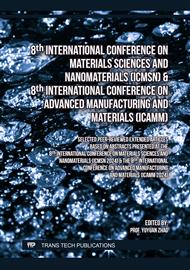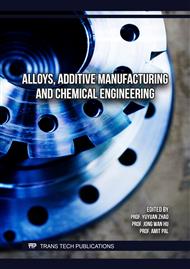[1]
R. DesRoches and B. Smith: Shape memory alloys in seismic resistant design and retrofit: a critical review of their potential and limitations, Journal of earthquake engineering 8(3) (2004), 415-429.
DOI: 10.1080/13632460409350495
Google Scholar
[2]
O. E. Ozbulut, S. Hurlebaus and R. DesRoches: Seismic response control using shape memory alloys: a review, Journal of Intelligent Material Systems and Structures 22(14),1531-1549 (2011).
DOI: 10.1177/1045389x11411220
Google Scholar
[3]
Z. Wang, J. Luo, W. Kuang, M. Jin, G. Liu, X. Jin and Y. Shen: Strain Rate Effect on the Thermomechanical Behavior of NiTi Shape Memory Alloys: A Literature Review, Metals 13(1) (2022), 58.
DOI: 10.3390/met13010058
Google Scholar
[4]
S. Gur and G.N. Frantziskonis: Linking simulations and experiments for the multiscale tracking of thermally induced martensitic phase transformation in NiTi SMA, Modelling and Simulation in Materials Science and Engineering 24(7) (2016), 075006.
DOI: 10.1088/0965-0393/24/7/075006
Google Scholar
[5]
G. N. Frantziskonis and S. Gur: Length scale effects and multiscale modeling of thermally induced phase transformation kinetics in NiTi SMA, Modelling and Simulation in Materials Science and Engineering 25(4) (2017), 045002.
DOI: 10.1088/1361-651x/aa6662
Google Scholar
[6]
S. Gur and G. N. Frantziskonis, K. Muralidharan: Atomistic simulation of shape memory effect (SME) and superelasticity (SE) in nano-porous NiTi shape memory alloy (SMA), Computational Materials Science 152 (2018), 28-37.
DOI: 10.1016/j.commatsci.2018.05.031
Google Scholar
[7]
S. Gur and G. N. Frantziskonis: Design of porous and graded NiTi smart energy absorbers considering synthetic uncertainty in parameters, Journal of Intelligent Material Systems and Structures 32(16) (2021), 1759-1780.
DOI: 10.1177/1045389x20977908
Google Scholar
[8]
L. Janke, C. Czaderski, M. Motavalli, and J. Ruth: Applications of shape memory alloys in civil engineering structures—Overview, limits and new ideas, Materials and structures 38(2005), 578-592.
DOI: 10.1007/bf02479550
Google Scholar
[9]
A. Tabrizikahou, M. Kuczma, M. Łasecka-Plura, E. N. Farsangi, M. Noori, P. Gardoni, and S. Li: Application and modelling of Shape-Memory Alloys for structural vibration control: State-of-the-art review, Construction and Building Materials 342(2022), 127975.
DOI: 10.1016/j.conbuildmat.2022.127975
Google Scholar
[10]
E. M. Mazzer, M. R. da Silva and P. Gargarella: Revisiting Cu-based shape memory alloys: Recent developments and new perspectives, Journal of Materials Research 37(1) (2022), 162-182.
DOI: 10.1557/s43578-021-00444-7
Google Scholar
[11]
B. Duran, K. C. Atlı, and Ö. Avşar: Superelastic cyclic properties of Cu-Al-Mn and Ni-Ti shape memory alloys for seismic mitigation. In 5th World Congress on Civil, Structural, and Environmental Engineering (CSEE 20) (2020).
DOI: 10.11159/icsect20.117
Google Scholar
[12]
S. N. S. Al-Humairi: Cu-based shape memory alloys: modified structures and their related properties, Recent Advancements in the Metallurgical Engineering and Electrodeposition, 25 (2020).
DOI: 10.5772/intechopen.86193
Google Scholar
[13]
I. López-Ferreño, J. F. Gómez-Cortés, T. Breczewski, I. Ruiz-Larrea, M. L. Nó and J. M. San Juan: High-temperature shape memory alloys based on the Cu-Al-Ni system: design and thermomechanical characterization, Journal of Materials Research and Technology 9(5) (2020), 9972-9984.
DOI: 10.1016/j.jmrt.2020.07.002
Google Scholar
[14]
H. Fu, S. Xu, H. Zhao, H. Dong and J. Xie: Cyclic stress-strain response of directionally solidified polycrystalline Cu-Al-Ni shape memory alloys, Journal of Alloys and Compounds 714(2017), 154-159.
DOI: 10.1016/j.jallcom.2017.04.234
Google Scholar
[15]
H. Fu, S. Song, L. Zhuo, Z. Zhang and J. Xie: Enhanced mechanical properties of polycrystalline Cu-Al-Ni alloy through grain boundary orientation and composition control, Materials Science and Engineering: A 650(2016), 218-224.
DOI: 10.1016/j.msea.2015.10.037
Google Scholar
[16]
J. Ibarra, San Juan, E. H. Bocanegra and M. L. Nó: Evolution of microstructure and thermomechanical properties during superelastic compression cycling in Cu–Al–Ni single crystals, Acta Materialia 55(14) (2007), 4789-4798.
DOI: 10.1016/j.actamat.2007.05.012
Google Scholar
[17]
B. Cladera, C. Weber, C. Leinenbach, M. Czaderski, Shahverdi and M. Motavalli: Iron-based shape memory alloys for civil engineering structures: An overview, Construction and building materials 63(2014), 281-293.
DOI: 10.1016/j.conbuildmat.2014.04.032
Google Scholar
[18]
X. Qiang, Y. Wu, Y. Wang and X. Jiang: Research Progress and Applications of Fe-Mn-Si-Based Shape Memory Alloys on Reinforcing Steel and Concrete Bridges, Applied Sciences13(6) (2023), 3404.
DOI: 10.3390/app13063404
Google Scholar
[19]
R. A. U. Rahman, D. Juhre and T. Halle: Review of types, properties, and importance of ferrous based shape memory alloys, Korean Journal of Materials Research 28(7) (2018), 381-390.
DOI: 10.3740/mrsk.2018.28.7.381
Google Scholar
[20]
X. L. Gu, Z. Y. Chen, Q. Q. Yu and E. Ghafoori: Stress recovery behavior of an Fe-Mn-Si shape memory alloy, Engineering Structures 243(2021), 112710.
DOI: 10.1016/j.engstruct.2021.112710
Google Scholar
[21]
Z. X. Zhang, C. Fang, Q. He, W. Shi and F. Zhang: Fe-SMA–Based Shear Panel Damper: Solution Treatment, Design, and Seismic Performance, Journal of Structural Engineering 150(4) (2024), 04024027.
DOI: 10.1061/jsendh.steng-13132
Google Scholar
[22]
S. Bhowmick and S.K. Mishra: FNCATB superelastic damper for seismic vibration mitigation, Journal of Intelligent Material Systems and Structures 27(15) (2016), 2062-2077.
DOI: 10.1177/1045389x15620039
Google Scholar
[23]
S. Bhowmick and S.K. Mishra: Ferrous SMA (FNCATB) based superelastic friction bearing Isolator (S-FBI) subjected to pulse type ground motions, Soil Dynamics and Earthquake Engineering 100 (2017), 34-48.
DOI: 10.1016/j.soildyn.2017.03.037
Google Scholar
[24]
ASTM, E8/E8M-16A Standard Test Methods for Tension Testing of Metallic Materials. 2016.
Google Scholar
[25]
MATLAB homepage, https://in.mathworks.com/
Google Scholar



